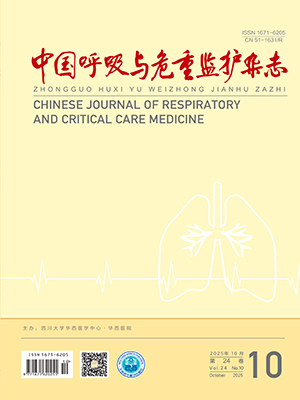Objective To investigate the prethrombotic state and effect of anticoagulation therapy in patients with chronic obstructive pulmonary disease(COPD) and ventilator-associated pneumonia (VAP).Methods Forty-six COPD patients were divided into VAP group(25 cases)and non-VAP group (21 cases).The VAP group were randomly subdivided into two groups:group A(conventional therapy group,n=13),group B(conventional therapy+anticoagulation therapy group,n=12).The D-dimer (DD),fibfinogen(FIB),pulmonary artery pressure(PAP)and the time of weaning were compared between these groups.Results In the COPD patients,the levels of DD,FIB and PAP were significantly increased in VAP group compared with non-VAP group[(0.50±0.26)mg/L,(3.67 ±0.88) L,(31.71 ± 5.66)mm Hg vs(0.23±0.12)mg/L,(1.56±0.45) L,(15.28 ±2.84)mm Hg,respectively,all P lt; 0.05].In the COPD patients with VAP,the levels of DD,the content of FIB,PAP and mortality were significantly lower in group B with shorter time of weaning compared with group A[(0.22±0.16)mg/L, (1.56±1.17)g/L,(16.00±2.48)him Hg,8.33% and(4.00±1.41)d vs(O/41±0.09)mg/L,(3.66± 1.03) L,(28.00±0.85)mm Hg,15.4% and(10.76±3.35)d,respectively,all P lt;0.05]. Conclusions Prethrombotic state exists in COPD patients with VAP.Aggressive anticoagulation on base of routine therapy,by ameliorating microcireulation,call shorten the time of weaning and reduce the mortalit in these patient
Citation: YAN Feng,LUO Wenling,WANG Ruiqin,CUI Rong. Prethrombotic state of chronic obstructive pulmonary disease patients with ventilator associated pneumonia and the efect of anticoagulation therapy. Chinese Journal of Respiratory and Critical Care Medicine, 2008, 08(6): 424-426. doi: Copy
Copyright © the editorial department of Chinese Journal of Respiratory and Critical Care Medicine of West China Medical Publisher. All rights reserved
-
Previous Article
A Survey on the Human Resource Allocation of Chengdu Rural/Community Health Service Organizations: A Pre-Survey Report of Three Circles, Seven Rural Hospitals/ Centers and Six Village Health Situations (Part Ⅱ) -
Next Article
Medical Residents in the Department of Internal Medicine at a Tertiary Hospital: a Survey of the Personnel Allocation and Their Workloads




